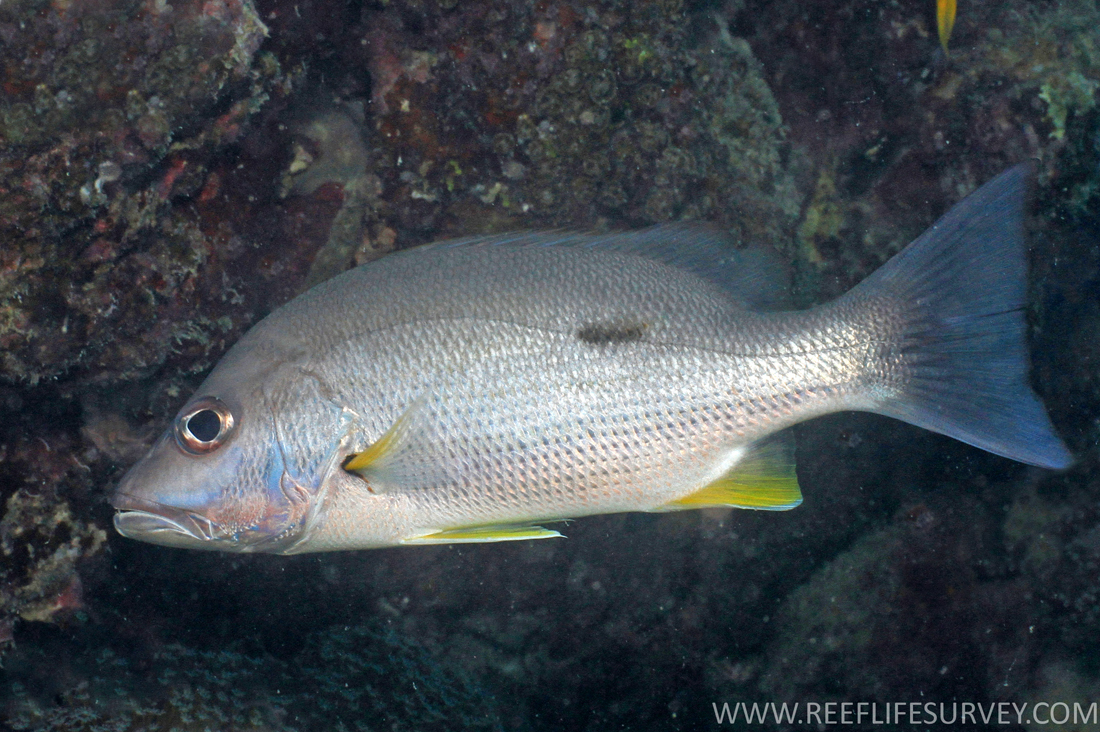- Classification
- ACTINOPTERYGII
- PERCIFORMES
- LUTJANIDAE
- Lutjanus
- monostigma
Onespot Snapper, Lutjanus monostigma (Cuvier 1828)
Other Names: Moses Perch, Onespot Seaperch, One-spot Sea-perch, One-spot Snapper

A Onespot Snapper, Lutjanus monostigma, on the Great Barrier Reef, Queensland. Source: Graham Edgar / Reef Life Survey. License: CC by Attribution
Summary:
A silvery pale yellowish, to pinkish or greyish tropical snapper with yellowish fins and a black spot or blotch over the lateral line below the anterior soft dorsal-fin rays. The spot is large and round in juveniles, and gradually fades, becoming smaller and more elongate with growth. The scale rows along the back rise obliquely above lateral line, and the preopercular notch is indistinct.
Cite this page as:
Bray, D.J. 2025, Lutjanus monostigma in Fishes of Australia, accessed 03 Jul 2025, https://fishesofaustralia.net.au/home/species/562
Onespot Snapper, Lutjanus monostigma (Cuvier 1828)
More Info
|
Distribution |
Houtman Abrolhos, and off shore reefs of north Western Australia, and Ashmore Reef in the Timor Sea, to the southern Great Barrier Reef, Queensland; also Cocos (Keeling) Islands and Christmas Island in the eastern Indian Ocean. Elsewhere the species occurs in the Indo-west-central Pacific. Individuals or occasionally small groups inhabit coral reefs, usually near caves, large coral formations and wreckage - mostly at depths of 1-30 m. |
|
Features |
Dorsal fin X, 13-14; Anal fin III, 8-9. Body moderately deep to somewhat slender, greatest depth 2.6-3.0 in SL; preopercular notch and knob poorly developed; vomerine tooth patch crescentic, without a medial posterior extension; tongue smooth, no teeth; gill rakers of first gill arch 7 + 11-12 = 18-19 (including rudiments); caudal fin truncate to slightly emarginate; scale rows on back rising obliquely above lateral line. |
|
Feeding |
Feeds mostly on fishes, but also consumes benthic crustaceans. |
|
Fisheries |
Taken with handlines, traps and gillnets and marketed fresh in many parts of its range. |
|
Similar Species |
The similar Moses' Snapper, Lutjanus russellii, differs in having a vomerine tooth patch with a medial posterior extension (vs. without medial posterior extension), yellow anal and pelvic fins, a dusky-red caudal fin, and the black spot is positioned mostly above the lateral line. |
|
Etymology |
The specific name is from the Latin mono- (= one) and stigma (= spot), in reference to the prominent black spot on the upper body (that fades with growth). |
|
Species Citation |
Mesoprion monostigma Cuvier in Cuvier & Valenciennes 1828, Histoire Naturelle des Poissons Vol 2: 446. Type locality: Seychelles. |
|
Author |
Bray, D.J. 2025 |
|
Resources |
Onespot Snapper, Lutjanus monostigma (Cuvier 1828)
References
Allen, G.R. 1985. FAO Species Catalogue. Snappers of the World. An annotated and illustrated catalogue of lutjanid species known to date. FAO Fisheries Synopsis No. 125, Vol. 6. Rome : FAO 208 pp.
Allen, G.R. 1997. Marine Fishes of Tropical Australia and South-east Asia. Perth : Western Australian Museum 292 pp. 106 pls.
Allen, G.R. & Erdmann, M.V. 2012. Reef fishes of the East Indies. Perth : Tropical Reef Research 3 vols, 1260 pp.
Allen, G.R. & Smith-Vaniz, W.F. 1994. Fishes of Cocos (Keeling) Islands. Atoll Research Bulletin 412: 1-21
Allen, G.R., Steene, R.C. & Orchard, M. 2007. Fishes of Christmas Island. Christmas Island : Christmas Island Natural History Association 2 edn, 284 pp.
Allen, G.R. & Talbot, F.H. 1985. Review of the snappers of the genus Lutjanus (Pisces: Lutjanidae) from the Indo-Pacific, with the description of a new species. Indo-Pacific Fishes 11: 1-87
Anderson, W.D. & Allen, G.R. 2001. Lutjanidae. pp. 2840-2918 in Carpenter, K.E. & Niem, V.H. (eds). The Living Marine Resources of the Western Central Pacific. FAO Species Identification Guide for Fisheries Purposes. Rome : FAO Vol. 5 2791-3379 pp.
Cuvier, G.L. in Cuvier, G.L. & Valenciennes, A. 1828. Histoire Naturelle des Poissons. Paris : Levrault Vol. 2 xxi, 2 + 490 pp., pls 9-40.
Grant, E.M. 1991. Fishes of Australia. Brisbane : EM Grant Pty Ltd 480 pp.
Hobbs, J-P.A., Newman, S.J., Mitsopoulos, G.E.A., Travers, M.J., Skepper, C.L., Gilligan, J.J., Allen, G.R., Choat, H.J. & Ayling, A.M. 2014. Checklist and new records of Christmas Island fishes: the influence of isolation, biogeography and habitat availability on species abundance and community composition. Raffles Bulletin of Zoology Supplement 30: 184–202
Hobbs, J-P.A., Newman, S .J., Mitsopoulos, G.E.A., Travers, M.J., Skepper, C.L., Gilligan, J.J., Allen, G.R., Choat, H.J. & Ayling, A.M. 2014. Fishes of the Cocos (Keeling) Islands: new records, community composition and biogeographic significance. Raffles Bulletin of Zoology Supplement 30: 203–219
Hutchins, J.B. 2001. Biodiversity of shallow reef fish assemblages in Western Australia using a rapid censusing technique. Records of the Western Australian Museum 20: 247-270
Kuiter, R.H. 1992. Tropical Reef-Fishes of the Western Pacific, Indonesia and Adjacent Waters. Jakarta : PT Gramedia Pustaka Utama 314 pp. pls.
Kuiter, R.H. 1996. Guide to Sea Fishes of Australia. A comprehensive reference for divers and fishermen. Sydney, NSW, Australia : New Holland Publishers xvii, 434 pp.
Randall, J.E., Allen, G.R. & Steene, R. 1997. Fishes of the Great Barrier Reef and Coral Sea. Bathurst : Crawford House Press 557 pp. figs.
Russell, B., Lawrence, A., Myers, R., Carpenter, K.E. & Smith-Vaniz, W.F. 2016. Lutjanus monostigma. The IUCN Red List of Threatened Species 2016: e.T194376A2325523. https://dx.doi.org/10.2305/IUCN.UK.2016-3.RLTS.T194376A2325523.en. Accessed on 26 March 2025.









